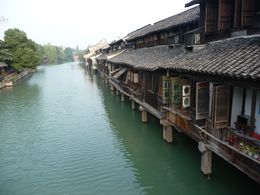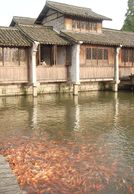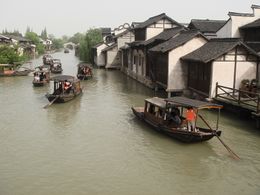ووژن Wuzhen
Wuzhen
乌镇 | |
|---|---|
| الترجمة اللفظية بالـ Chinese | |
| • Characters | 乌镇 |
| • Pinyin | Wūzhèn |
![The canals of Wuzhen have led to it being nicknamed the "Venice of the East"[1]](/w/images/thumb/7/7a/Bridge_in_Wuzhen_03.JPG/250px-Bridge_in_Wuzhen_03.JPG) The canals of Wuzhen have led to it being nicknamed the "Venice of the East"[1] | |
| الإحداثيات: 30°44′46″N 120°29′44″E / 30.74611°N 120.49556°E | |
| Country | الصين |
| Province | Zhejiang |
| Prefecture | Jiaxing |
| City | Tongxiang |
| المساحة | |
| • الإجمالي | 71٫19 كم² (27٫49 ميل²) |
| التعداد | |
| • الإجمالي | 60٬000 |
| • الكثافة | 840/km2 (2٬200/sq mi) |
| منطقة التوقيت | UTC+8 (China Standard) |
| Postal code | 314501 |
| مفتاح الهاتف | 0573 |
Wuzhen (الصينية المبسطة: 乌镇; الصينية التقليدية: 烏鎮; پنين: Wūzhèn, Wu: Whu-tsen lit. "Wu Town") is a historic scenic town, part of Tongxiang, located in northern Zhejiang Province, China.
It lies within the triangle formed by Hangzhou, Suzhou and Shanghai. Covering an area of 71.19 km2 (27.49 sq mi), Wuzhen has a total population of 60,000, of which 12,000 are permanent residents.[2]
Wuzhen is the permanent host place of the World Internet Conference since 2014.[3]
الموقع
Located in the centre of the six ancient towns south of Yangtze River, 17 كيلومتر (11 mi) north of the city of Tongxiang, Wuzhen displays its history through its ancient stone bridges, stone pathways and delicate wood carvings.
أشخاص بارزون
Mao Dun, a renowned modern Chinese revolutionary writer, was born in Wuzhen, and his well-known work, 'The Lin's Shop', describes the life of Wuzhen. In 1991, Wuzhen was authorized as the Provincial Ancient Town of History and Culture and ranked first among the six ancient towns south of the Yangtze River.[بحاجة لمصدر]
جسر ضمن جسر
The "Bridge within a Bridge" is a scenic attraction created by two ancient bridges, the Tongji Bridge which crosses the river from east to west and the Renji Bridge running from south to north that joins the former at one end. Either of two bridges can be seen through the arch of the other, hence the name. Having been rebuilt five times, Tongji Bridge is a 28.4 متر (93 ft) and 3.5 متر (11 ft) one-curvature arch bridge, with a span of 11.8 متر (39 ft). Renji Bridge, which has also undergone repairs during its history, has a length of 22.6 متر (74 ft), a width of 2.8 متر (9.2 ft) and a span of 8.5 متر (28 ft).
Demonstration in the traditional workshops district display traditional crafts as the printing and dyeing of blue printed fabrics, the primitive techniques of cloth shoe making and tobacco-planing. Visitors may operate the machines to get an idea of how the original work was carried out over 200 years ago. The local houses here are decorated with carved wooden and stone doors and windows.
معرض
Koi in a pond
انظر أيضاً
المراجع
- ^ Seale, Shelley. "The Water Town of Wuzhen: The Venice of China". Go Nomad. Retrieved 21 November 2014.
- ^ "About Wuzhen". Wuzhen Town. Retrieved March 7, 2011.
- ^ "World Internet Conference". World Internet Conference. Retrieved December 16, 2015.
وصلات خارجية
- Pages using gadget WikiMiniAtlas
- Short description is different from Wikidata
- Coordinates on Wikidata
- Articles containing simplified Chinese-language text
- Articles containing traditional Chinese-language text
- Articles with unsourced statements from March 2011
- Traditional folk houses in China
- Township-level divisions of Zhejiang
- Tourist attractions in Zhejiang
- Jiaxing









